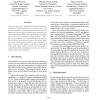Free Online Productivity Tools
i2Speak
i2Symbol
i2OCR
iTex2Img
iWeb2Print
iWeb2Shot
i2Type
iPdf2Split
iPdf2Merge
i2Bopomofo
i2Arabic
i2Style
i2Image
i2PDF
iLatex2Rtf
Sci2ools
115
click to vote
ICIAP
2001
Springer
2001
Springer
Representing Volumetric Vascular Structures Using Curve Skeletons
This paper describes a technique to represent relevant information of tree-like structures in a compact way. The technique is general. In the application described here, the images are obtained with contrast-enhanced magnetic resonance angiography (MRA). After segmentation, the vessels are reduced to fully reversible surface skeletons. Thereafter, a novel approach to curve skeletonization based on the detection of junctions and curves in the surface skeleton is used. This procedure results in a good description of the tree structure of the vessels, where they are represented with a much smaller number of voxels. This representation is suitable for further quantitative analysis, e.g., measurements of vessel width and length.
ICIAP 2001 | Image Processing | Magnetic Resonance Angiography | Reversible Surface Skeletons | Surface Skeleton |
Related Content
| Added | 08 Dec 2009 |
| Updated | 08 Dec 2009 |
| Type | Conference |
| Year | 2001 |
| Where | ICIAP |
| Authors | Gabriella Sanniti di Baja, Ingela Nyström, Stina Svensson |
Comments (0)

